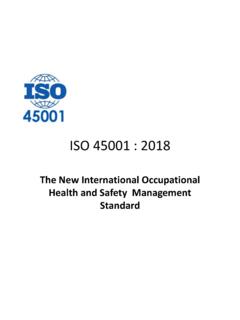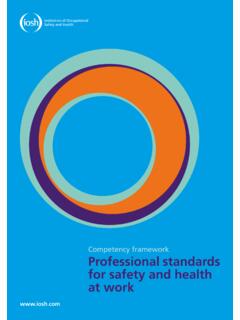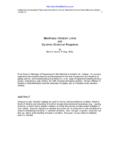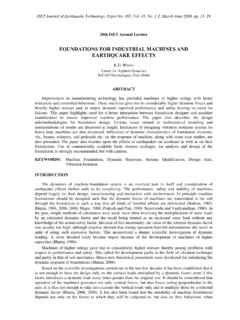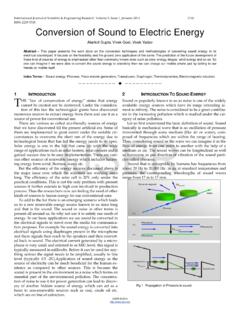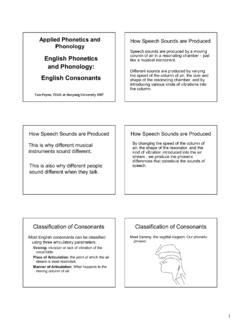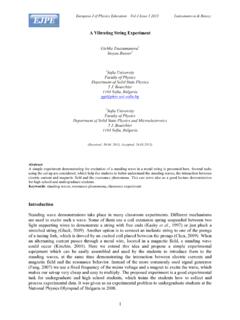Transcription of OWAS (Ovako Working posture Assessment System)
1 owas 1(6). owas (Ovako Working posture Assessment System). General description and development of the method owas identifies the most common work postures for the back (4 postures), arms (3 postures) and legs (7 postures), and the weight of the load handled (3 categories). Whole body posture is described by these body parts with a four digit-code. These 252 postures have been classified to four action categories indicating needs for ergonomic changes. The observations are made as "snapshots" and sampling has usually been with constant time intervals. owas was developed in Finland in a steel industry companly, Ovako Oy, in 1973 to describe the workload in the overhauling of iron smelting ovens (Karhu 1977). A portable computer system for coding and analysis of owas has been developed (Kivi 1991). Exposure descriptors Exposure Description of exposure magnitude/amplitude duration frequency posture 4 postures of back, 3 of upper x.
2 X. limbs, 7 for lower limbs movements .. (external) force weight of the load <10kg, 10- x.. x. 20kg, >20kg vibration - .. contact forces - .. No exact cut-off limits for the definition of posture classes Resource demands and usability Equipment needed Checklist. A computerized system, WinOWAS is available free on charge, (English and Finnish version). Process of coding and analysis Frequency of postures is counted usually by action categories and by tasks /jobs Output type/level (risk Assessment ). Frequency of postures by action categories June 2009. owas 2(6). Criteria to help the evaluator to make decision The observed posture combinations are classified into four ordinal scale action categories, which are based on expert's estimates of the health hazards of each work posture or posture combination (Mattila 1993). Fields of the Working life where the method has been used Steel industry workers (Burdorf 1991, Karhu 1981, Malchaire 1991); construction workers (Burdorf 1991, Kivi 1991, Mattila 1993, Saurin 2006, van der Beek 2005); health care workers (Best 1997, de Bruijn 1998, Doormaal 1995, Engels 1994, Engels 1994, Hignett 1995, Hignett 1996, Kant 1992).
3 Transport company workers (crane drivers, carrier drivers and administrators) (Burdorf 1992); worklift truck drivers (Hoy 2005); workers in repair and maintenance of automobiles (Kant 1990); preschool workers (modified owas (Grant 1995); manufacturing industries (Kayis 1996); residential carpenters (Gilkey 2007); sedentary workers (Burdorf 1991); tank terminal workers (Burdorf et al 1997); straddle carrier drivers, crane operators, office workers, sawyers and woodworking machinists, packers in auction of flowers (Burdorf 1992); warehouse workers (Carrasco 1995, Ljungberg 1989); workers in fishing wessels (Fulmer 2002); agricultural workers (Gangopadhyay 2005, Nevala-Puranen 1995, Nevala-Puranen 1996, Perki -M kel 2005, Tuure 1992); sorters of postal parcels (Louhevaara 1990);. construction workers and vehicle inspectors (Louhevaara 1999); home care workers (Pohjonen 1998);. road maintenance workers (Roja 2006); workers in professional fishing (Torner 1988); workers in ship maintenance (van Wendel de Joode 1997); loggers (V yrynen 1991); workers in chemical plant (V yrynen 1994); workers in distribution centre (Wright 1999).)
4 Validity Face validity / Contents validity Does the method seem to be valid for the aimed purpose? (Karhu 1977, Louhevaara 1992) yes +- 1. The contents of the method is such that a relevant Assessment x can be expected Comments: Assessments of neck and elbows/wrists are missing 2. Items to be observed have a sound basis x 3. sound operationalization of the items to be observed x 4. sound process to collect data x 5. sound process to get the output of the collected data x Comments: Based on frequency distribution, does not account on the duration of individual Working sequences. 6. Output can help in decision making x Concurrent validity How well does the method correspond with more valid method/s? 1) Comparison of owas , Borg RPE scale, and biomechanical model (Kayis 1996) (Results p. 259 Tab 9). "the majority of the results of risk Assessment (80%) are in agreement with each other.". June 2009.
5 owas 3(6). 2) Comparison of owas , Borg RPE scale, and Body Part Discomfort Scale (Olendorf 2001) (Results p. 1356-59, Fig 4-7, 9). - Laboratory experiment: Static holding of boxes in predetermined postures for 20 sec. 3) Comparison of owas with the European Standard for ergonomic design (CEN, 1994) (Vedder 1998). Comments: Risk profiles of machines have been evaluated with the two methods. However, the individual postures have not been compared side by side and this is not a real validation study. 4) Trunk bending using owas and direct technical measures (Burdorf 1992) (Results: p. 264-65). - 16 employees in dynamic work, 14 sedentary workers - Outcome measured as duration in bent postures 5) Manual lifting using modified owas , NIOSH lifting equation, Arbow method, and practioner's method (van der Beek 2005) (Results: p. 217, Table 6). - Construction work "the three tasks in scaffolding are ranked according to their physical demands of lifting using the four different three methods based on the NIOSH lifting equation resulted in about the same ranking order (transport > construction > dismantlement).
6 In contrast, construction was ranked highest in the method using the systematic observations, while transport was given the lowest ranking.". "Predictive validity". How well has the risk-estimation of the method been shown to be associated with or predicting musculoskeletal disorders (MSDs)? 1) Building industry (Burdorf 1991); (Results: p. 914: ). Association between postural load and symptoms Intra-observer repeatability (within observers). 1) Observations of postures from slides after 4 weeks and months (de Bruijn 1998) (Results Tab 1). Estimation of postures from slides shown for 3 sec Kappa-values all > 2) Reassessment of postures from pictures after 3 weeks (Kee 2007). p. 5, Comparison scheme: "The postures were reassessed after 3 weeks by the ergonomist. The intra-rater reliabilities for owas , RULA, and REBA were , , and , respectively.". June 2009. owas 4(6). Inter-observer repeatability (between observers).
7 1) Agreement between two workers, two work-study engineers, and morning/afternoon observations (Karhu 1977)(Results: Tab 2). 52 tasks were analysed and a total of 36240 observations were made agreement for work study engineers was 93%. 2) Inter-rater repeatability (Kivi 1991); (p. 44). "Inter-rater reliability coefficients" >85%. 3) Observations of postures from slides after 4 weeks and months, two observers (de Bruijn 1998) (Results Tab 1). Kappa-values for back, legs and head > , for arms 4) Two observers analyzed 593 different postures of 18 construction workers, using a compurized owas method (Mattila 1993). "Inter-rater reliability coefficients" >97%. Conclusions Strengths of the method Widely used and documented Limitations in the use of the method Does not separate right and left upper extremities; Assessments of neck and elbows/wrists are missing; posture coding "crude" for shoulders Time-consuming Does not consider repetition or duration of the sequential postures Decissions rules based on frequency distribution are arbitrary The use of owas requires thorough training of the observation technique as well as skills to design the observational strategy To whom can this method be recommended?
8 Researchers familiar with the method References Best M. An evaluation of Manutention training in preventing back strain and resultant injuries in nurses. Safety Science. 1997;25(1-3):207-22. Burdorf A. Sources of variance in exposure to postural load on the back in occupational groups. Scand J Work Environ Health. 1992;18(6):361-7. Burdorf A &al. Measurement of trunk bending during work by direct observation and continuous measurement. Applied Ergonomics. 1992;23(4):263-7. June 2009. owas 5(6). Burdorf A &al. Postural load and back pain of workers in the manufacturing of prefabricated concrete elements. Ergonomics. 1991;34(7):909-18. Burdorf A & Laan J. Comparison of methods for the Assessment of postural load on the back. Scand J. Work Environ Health. 1991;17(6):425-9. Carrasco C &al. Packing products for customers. An ergonomics evaluation of three supermarket checkouts. Applied Ergonomics.
9 1995;26(2):101-8. de Bruijn I &al. A simple method to evaluate the reliability of owas observations. Applied Ergonomics. 1998;29(4):281-3. Doormaal MTAJ &al. Physical workload of ambulance assistants. Ergonomics. 1995;38(2):361-76. Engels JA &al. An owas -based analysis of nurses' Working postures. Ergonomics. 1994;37(5):909- 19. Engels JA &al. Physical work load and its Assessment among the nursing staff in nursing homes. journal of Occupational Medicine. 1994;36(3):338-45. Fulmer S & Buchholz B. Ergonomic exposure case studies in Massachusetts fishing vessels. Am J Ind Med. 2002;Suppl 2:10-8. Gangopadhyay S &al. An ergonomic study on posture -related discomfort among preadolescent agricultural workers of West Bengal, India. Int J Occup Saf Ergon. 2005;11(3):315-22. Gilkey DP &al. Low back pain among residential carpenters: ergonomic evaluation using owas and 2D compression estimation. Int J Occup Saf Ergon.
10 2007;13(3):305-21. Grant KA &al. Work activities and musculoskeletal complaints among preschool workers. Appl Ergon. 1995;26(6):405-10. Hignett S. Fitting the Work to the Physiotherapist. Physiotherapy. 1995;81(9):549-52. Hignett S. Postural analysis of nursing work. Appl Ergon. 1996;27(3):171-6. Hoy J &al. Whole body vibration and posture as risk factors for low back pain among forklift truck drivers. journal of sound and vibration . 2005;284(3-5):933-46. Kant I &al. Observations of Working postures in garages using the Ovako Working posture Analysing System ( owas ) and consequent workload reduction recommendations. Ergonomics. 1990;33(2):209- 20. Kant IJ &al. A survey of static and dynamic work postures of operating room staff. International Archives of Occupational and Environmental Health. 1992;63(6):423-8. Karhu O &al. Observing Working postures in industry: Examples of owas application.
